Introduction
140th Year of
COMMENCEMENT
Spring 2024
Alma Mater
Hail To Thee, Our Alma Mater, Colorado State.
Memories Are Everlasting Of This Place So Great!
May Thy Green And Gold Unite Us, Loyal Ever Be.
Colorado State, Our Alma Mater, Hail, All Hail, To Thee
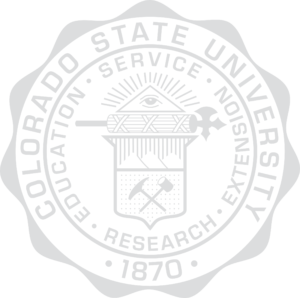
Colorado State University Seal
The Colorado State University seal is a modification of the official State of Colorado Seal, approved by the first General Assembly of the State of Colorado on March 15, 1877.
The seal consists of the eye of God within a triangle, from which golden rays radiate. Below the triangle is a bundle of birch or elm rods, wrapped with a scroll and around a battle axe bound by thongs. The scroll is called a Roman fasces and is the insignia of a republican form of government. The bundle of rods bound together symbolizes strength, which is lacking in the single rod. The axe symbolizes authority and leadership. Below the scroll is the heraldic shield bearing across the top three snow-capped mountains. The lower half of the shield has two miner’s tools, the pick and sledge hammer, crossed on the ground.
As the University evolved, the seal was updated to reflect changes to the school’s name. The original name was the State Agricultural College. In 1935, the name changed to Colorado State College of Agricultural and Mechanical Arts. In 1957, the name was again changed – this time to Colorado State University.
The original seal was made of hand-tooled leather. Damaged during the campus flooding of 1938, the original border was cut away in a random and arbitrary fashion and stitched back down on a new piece of leather in a scallop-like manner, giving the seal its current appearance.
Principles of Community
The Principles of Community support the Colorado State University mission and vision of access, research, teaching, service and engagement. A collaborative and vibrant community is a foundation for learning, critical inquiry, and discovery. Therefore, each member of the CSU community has a responsibility to uphold these principles when engaging with one another and acting on behalf of the University.
Inclusion: We create and nurture inclusive environments and welcome, value and affirm all members of our community, including their various identities, skills, ideas, talents and contributions.
Integrity: We are accountable for our actions and will act ethically and honestly in all our interactions.
Respect: We honor the inherent dignity of all people within an environment where we are committed to freedom of expression, critical discourse, and the advancement of knowledge.
Service: We are responsible, individually and collectively, to give of our time, talents, and resources to promote the well-being of each other and the development of our local, regional, and global communities.
Social Justice: We have the right to be treated and the responsibility to treat others with fairness and equity, the duty to challenge prejudice, and to uphold the laws, policies and procedures that promote justice in all respects.
Land Acknowledgment
Colorado State University acknowledges, with respect, that the land we are on today is the traditional and ancestral homelands of the Arapaho, Cheyenne, and Ute Nations and peoples. This was also a site of trade, gathering, and healing for numerous other Native tribes. We recognize the Indigenous peoples as original stewards of this land and all the relatives within it. As these words of acknowledgment are spoken and heard, the ties Nations have to their traditional homelands are renewed and reaffirmed.
CSU is founded as a land-grant institution, and we accept that our mission must encompass access to education and inclusion. And, significantly, that our founding came at a dire cost to Native Nations and peoples whose land this University was built upon. This acknowledgment is the education and inclusion we must practice in recognizing our institutional history, responsibility, and commitment.
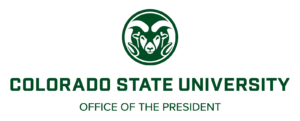
102 Administration Building | 0100 Campus Delivery | Fort Collins, Colorado 80523-0100
(970) 491-6211 | FAX (970) 491-0501 | www.colostate.edu
Spring 2024
Dear Graduates,
On behalf of the faculty, staff, students, and alumni of CSU, I applaud you! Graduation marks your transition from CSU students to CSU alumni. I know whatever you do in the next phase of life, each one of you will find new ways to make this world better. You are well equipped to lead, to serve the changing needs of society, and to contribute to our democracy. The skills and talents you have demonstrated here at CSU will serve you well as you solve local issues and great global challenges.
Your success today is testament to your ability to meet opportunities and challenges. You’ve learned to persist, support one another, and take action to advance your goals. Today we commend you for reaching of one of these goals. Your CSU degree will make a tremendous difference. We know that college graduates are more engaged in their communities, earn more, enjoy better health, and have greater career choices and successes. We are so proud that you reached this milestone, and are excited about the opportunities that lie ahead of you.
As you celebrate your accomplishments, you may also be reflecting on the people who have supported you along your journey. As you build your lives, you will have power to make a similar difference for others. Resolve to support, mentor, and befriend people in your workplaces, neighborhoods, and families. We have seen your compassion and involvement here on campus, and we know you will create opportunities for others and will continue to build strong communities.
One community you join today is the worldwide family of CSU alumni. You will always be Rams, and we want to continue to support your success. As an alumna and lifetime member of CSU’s Alumni Association myself, I hope you will stay connected with your classmates. We know you will meet many fellow Rams from other classes and disciplines throughout your careers and lives. Please come back and visit often.
We can’t wait to hear about all the ways you’ll make an impact on our world. All of us at CSU admire your achievements and support your future aspirations.
My very best wishes to each of you,
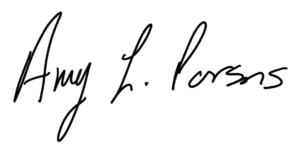
Amy Parsons
President, Colorado State University
A History of Colorado State University
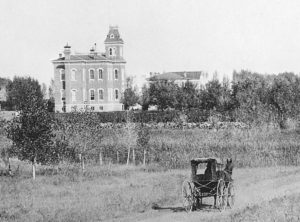
Colorado State University originated in 1870 when the territorial legislature established an agricultural college at Fort Collins. This school qualified for endowment under the Morrill Act of 1862, which provided federal land grants to academic institutions offering instruction in “such branches of learning as are related to agriculture and the mechanic arts” and promoting “the liberal and practical education of the industrial classes in the several pursuits and professions of life.” Ideally, land-grant schools would make higher education more useful, accessible, and democratic.
Nearly a decade passed before classes began at Fort Collins, but in the interim, experimental work was conducted on the campus farm. How could the emerging modern sciences of physics, chemistry, and biology be applied to Colorado’s distinctive agricultural conditions? Which were the most suitable methods of soil use, irrigation, crop selection, animal care, and pest control? Answers demanded careful study, which an agricultural experiment station would soon provide. Research thus preceded teaching.
On September 1, 1879, President Elijah E. Edwards and a two-member faculty welcomed the first students to the college. In the beginning, a single course of study served all, and the original graduating class – George H. Glover, Leonidas Loomis, and Libby Coy – received degrees on June 5, 1884. By the turn of the century, however, the curriculum included fully developed majors in agriculture, engineering, and home economics, along with fledgling graduate-level work. Dedicated faculty contributed to this development, among them James Lawrence, Clarence Gillette, Theodosia Ammons, and Elwood Mead. Mead, for example, introduced the first instructional program in irrigation engineering to be offered by an American college or university, and Lake Mead, Nevada, commemorates his subsequent professional esteem.
Outreach augmented research and teaching. Knowledge generated in Fort Collins could benefit Coloradans beyond the home campus, and in 1880, the college began offering farmers’ institutes at various locations. Eventually, extension agents would provide locally focused service in all Colorado counties and launch enduring programs, such as 4-H. Research, teaching, and outreach were all key college activities when Charles A. Lory began a 31-year tenure as president in 1909. A former ditch rider whose family had homesteaded in Colorado, Lory imbued the school with a commitment to practical education and service to the state. During his presidency, enrollments grew from 217 to 2,048, and the college developed into a well-rounded technical institution. By 1940, degrees were available in agriculture, engineering, home economics, veterinary medicine, forestry, vocational education, agricultural economics, and rural sociology. Notable faculty of the Lory era included Inga Allison, Lawrence Durrell, Walter J. Morrill, Isaac E. Newsom, Elizabeth Forbes, and Ruth J. Wattles.
These years also featured extracurricular activities and campus traditions. Fraternity and sorority life, Coach Harry Hughes’ football teams, and painting the “A” all left indelible memories. So did the calamity of the Great Depression, which posed exceptional challenges for Colorado’s land-grant institution as it worked to mobilize outreach support for the state’s hard-hit rural areas.
American involvement in World War II threw normal college routines into disarray. Enrollments plummeted as students and faculty left Fort Collins for military service. Although the college remained open because of President Roy Green’s success in bringing military training programs to the campus, national defense rather than collegiate goals prevailed. Research and extension efforts strongly emphasized agricultural output.
The post-war years saw an influx of veterans attending college on the G.I. Bill. In addition, Cold War tensions led to vastly augmented federal support for scientific research and training. Sponsored projects proliferated, as did graduate programs.
William E. Morgan, who became president in 1949, led the school’s emergence as a modern educational institution. A prudent planner, he foresaw the need for major campus expansion, identified areas of excellence, and encouraged their development. In 1955, the college awarded its first Ph.D. degree (to Adrian R. Chamberlain) and two years later changed its name to Colorado State University. Curricular improvements in the liberal arts, library acquisitions, and international programs gave legitimacy to the title of “university.”
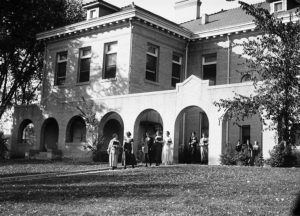
During the 1960s, enrollments soared from 6,131 to nearly 17,000, enabling gifted teachers, such as Willard Eddy and Meyer Nathan, to influence numerous students. Young people of this era also seemed determined to exercise an influence of their own by challenging perceived injustices. Concerns about racism, military power, environmental despoliation, discrimination against women, and rules governing student behavior provoked protests.
Adrian R. Chamberlain succeeded William E. Morgan as president in 1969 amid campus unrest that culminated in the burning of the Old Main building in 1970. Chamberlain worked to consolidate university changes during a period of less rapid growth. By the conclusion of his 11-year tenure, the boom in American higher education had ended, along with the moral fervor of a youthful generation. Good jobs now elicited greater concern than good causes.
During the 1980s, Colorado State University faced many questions. Which programs would best serve a dynamic modern society? Could traditional commitments to agriculture and rural Colorado be balanced against escalating urban needs and international involvements? What role should computers and electronic networks play in facilitating education? The university addressed these and other critical issues despite administrative upheaval that featured three different presidents within a four-year period.
The 1990s imposed both new and traditional demands upon Colorado State University. Particularly notable was the flood of July 28, 1997. Despite devastating damage to the campus, including Morgan Library and the Lory Student Center Bookstore, CSU managed to start Fall Semester classes on time. This achievement reflected remarkable effort, which President Albert Yates defined as a challenge to make the university into “a better and stronger place in all of its dimensions.” During his 13-year presidency, which began in 1990, Yates provided leadership that significantly advanced this goal, seeking, in his words, to “always turn adversity to advantage.” CSU emerged from the flood with an enhanced sense of community, and its rebuilt campus was functionally and aesthetically superior to the earlier one. Under Yates, the quality of undergraduate and graduate education and research steadily improved, along with opportunities for women and underrepresented minorities. Faculty such as Temple Grandin, Stanley Shumm, George Seidel, Stephen Withrow, Diana Wall, and Holmes Rolston achieved international renown, thereby enhancing CSU’s scientific and scholarly stature.
Intercollegiate athletics also flourished. Sonny Lubick’s winning football program, formation of the Mountain West Conference, and unprecedented success for women’s teams highlighted this trend. Olympic champion swimmer Amy Van Dyken and basketball All-American Becky Hammon were among the school’s best-known athletes.
Recently, CSU, like most public universities, has been severely tested by state, national, and global economic problems, along with competition for students by peer institutions and proliferating online academic programs. It has responded by diversifying resources, maintaining fiscal stability, and pursuing appropriate goals. For example, environmentalism has become an institutional objective, rekindling CSU’s longstanding research and teaching expertise in this realm. The university has emphasized science, technology, engineering, and mathematics education, while concurrently promoting the values of international understanding and responsible community involvement. It also launched a significant building program that initially benefited from bargain construction savings during the Great Recession and consistently low interest rates. Additions included living-learning residence halls, technology-enabled classrooms, a totally refurbished Student Center, and an on-campus stadium. Rarely has CSU’s commitment to the “power of place” been more evident than in the transformational character of its campus during the past decade – functionally, aesthetically, and sustainably.
Anthony A. Frank, inaugurated as CSU’s president in 2009, facilitated these changes. A faculty member since 1993, he subsequently held key administrative positions and worked actively to advance institutional priorities that embodied its land-grant educational heritage. Frank’s ten-year presidency emphasized academic excellence and the principles of inclusion, service, and social justice, providing a solid foundation for the work of Joyce McConnell, who became the first woman president of the institution in 2019, as CSU began celebrations of its 150th anniversary. During 2020 and 2021 McConnell led the university through an unprecedented transformation of teaching, research, and service necessitated by the COVID-19 pandemic. As we move purposefully into the future, this transformative work continues under the direction of Amy Parsons, who took office as CSU’s 16th president on February 1, 2023.
Today, tradition finds renewal in the academic ceremony of commencement – simultaneously celebrating past accomplishment, transition, and future promise. Since 1884, Colorado State University has bestowed 303,897 degrees. At present, 25,898 on-campus students, representing 107 nations, receive instruction from 2,135 faculty in eight separate colleges, plus the Graduate School. Research expenditures total $498.1 million annually. This vitality is rooted in a dynamic legacy that enables Colorado State University to address the challenges of the post-9/11 era. Historically, this school has embraced democratic opportunity, rewarded competence and merit, and instilled perseverance. It has advanced wisdom as well as knowledge. These values are crucial to sustaining human civilization in the 21st century.
– James E. Hansen II, Professor Emeritus of History
– Linda M. Meyer, Archivist, CSU Libraries
Board of Governors of the Colorado State University System
The Board of Governors consists of 15 members, nine of whom are appointed by the governor of Colorado to serve four-year terms as voting members. Voting members may be appointed to a maximum of two four-year terms. The six non-voting members represent Colorado State University, Colorado State University-Pueblo, and Colorado State University-Global Campus. One faculty member and one student leader are representatives from each university.
John Fischer, Chair
Dr. Nathaniel “Nate” Easley, Jr., Vice Chair
Kenzo Kawanabe, Treasurer
Elizabeth Markey, Secretary
Polly Baca
Ray Baker
Dominic DiSanti
Kim Jordan
Louis Martin
Dr. Andrew Norton, Faculty Representative, Colorado State University (Non-Voting Member)
Dr. Jon Pluskota, Faculty Representative, Colorado State University-Pueblo (Non-Voting Member)
Dr. Susan Aloi, Faculty Representative, Colorado State University-Global Campus (Non-Voting Member)
Nick DeSalvo, Student Representative, Colorado State University (Non-Voting Member)
Gavin Graham, Student Representative, Colorado State University-Pueblo (Non-Voting Member)
Laxman Adhikari, Student Representative, Colorado State University-Global Campus (Non-Voting Member)
Colorado State University Leadership
Dr. Anthony A. Frank, Chancellor of the Colorado State University System
Amy Parsons, J.D., President
Dr. Marion K. Underwood, Provost and Executive Vice President
Brett Anderson, Special Advisor to the President and Chancellor
Brandon Bernier, Vice President for Information Technology and Chief Information Officer
Dr. Kauline Cipriani, Vice President for Inclusive Excellence
Derek Dictson, Vice President for University Advancement
Kathleen Fairfax, Vice Provost for International Affairs
Brendan Hanlon, Vice President for University Operations and Chief Financial Officer
Kyle Henley, Vice President for Marketing and Communications
Dr. Blanche Hughes, Vice President for Student Affairs
Dr. Susan James, Vice Provost for Faculty Affairs
Dr. Laura Jensen, Vice Provost for Planning and Effectiveness
Jason Johnson, J.D., General Counsel
Kevin MacLennan, Interim Vice President for Enrollment and Access
Dr. Rick Miranda, Senior Vice President
Jannine Mohr, J.D., Deputy General Counsel
Dr. Cassandra Moseley, Vice President for Research
Rico Munn, Chief of Staff
Dr. James Pritchett, Vice President for Engagement and Extension
Eric Ray, Vice President of Human Resources
Dr. Thomas Siller, Interim Vice Provost for Undergraduate Affairs
Dr. Melinda Smith, Chair, Faculty Council
Dr. Colleen Webb, Vice Provost for Graduate Affairs and Dean of the Graduate School
John Weber, Interim Director of Athletics
Dr. A. Alonso Aguirre, Dean of the Warner College of Natural Resources
Dr. Elissa Braunstein, Interim Dean of the College of Liberal Arts
Dr. Karen Estlund, Dean of CSU Libraries
Dr. Janice Nerger, Dean of the College of Natural Sciences
Dr. James Pritchett, Dean of the College of Agricultural Sciences
Dr. Allen Robinson, Dean of the Walter Scott, Jr. College of Engineering
Dr. Sue VandeWoude, Dean of the College of Veterinary Medicine and Biomedical Sciences
Dr. Beth Walker, Dean of the College of Business
Dr. Lise Youngblade, Dean of the College of Health and Human Sciences
